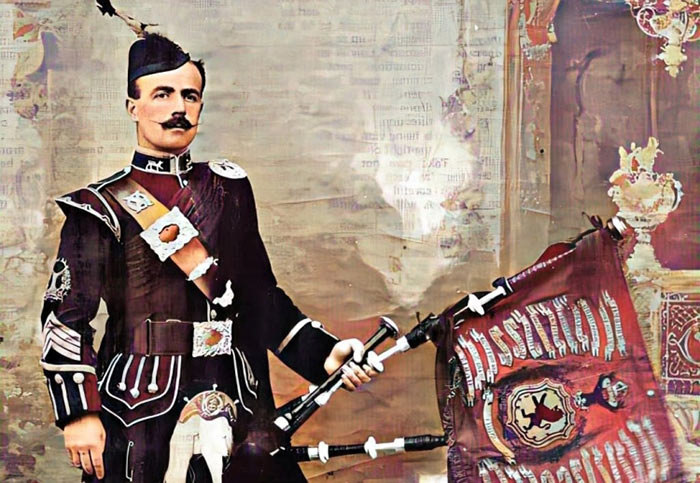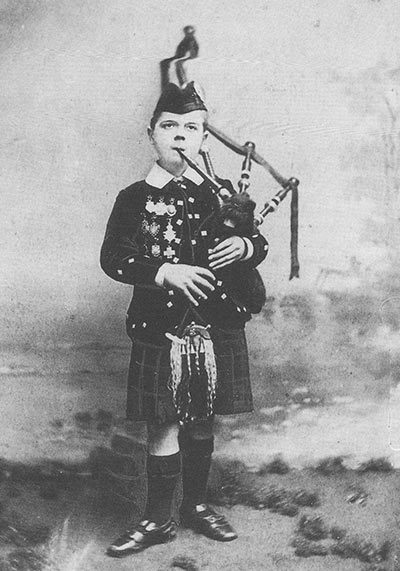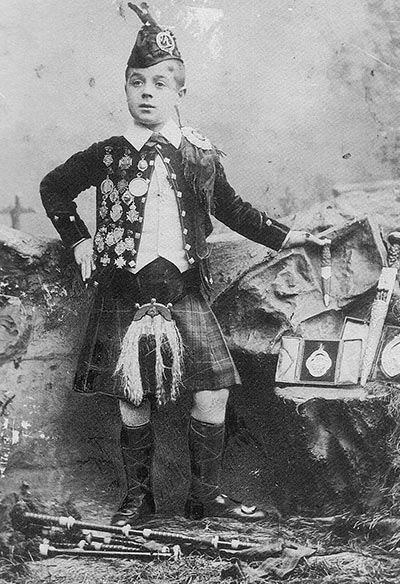
Much has been written about the celebrated piper George S McLennan, lauded not only for his brilliant playing but also his masterful compositions. This account we believe is from the Oban Times. It does not have a precise date as our copy is obscure, but from reading it it was clearly published several years in advance of the outbreak of war in 1914. It is important to us in that it is written without the posthumous reverence we are accustomed to in articles about GS, though reverent it undoubtedly is. By John James Miller, it is headed ‘Record of Scotland’s Pipers’ and is part of a newspaper series more of which has come to hand. Other excerpts will be published here in due course. GS is pictured above in 1910.
Anyone who has studied the latter-day story of pipe music knows that the name of McLennan is written indelibly across its page. It must be so since the name was borne by such a marvellous exponent as was ‘Willie’ McLennan, the world-famous champion, who, whilst still in the flood tide of success and the prime of his days, was called to the shadow land.
One cannot quote the name without touching, however briefly, on Willie’s merits. At the same time I must make it plain that the Mac whose record I now detail needs no borrowed lustre.
A native of Edinburgh, Pipe Major George Stewart McLennan was born on February 9th, 1884. He is the youngst pipe major in the British Army. Pipe music was a part of Mac’s schooling. It could not be otherwise.
‘Willie’ McLennan was his cousin and both of them were taught by GS’s father Lieutenant John McLennan of Edinburgh City Police, as sound a theorist in the art of piping as you may meet.
The composition lately published by this gentleman, and entitled ‘Piobaireachd as McCrimmon Played It’ is a fair enough criterion of his genius.
Then young Mac had also the advantage of many a helpful hint from his maternal uncle, Pipe Major John Stewart, a grand old piper.
Nurtured in such such atmosphere, it is not surprising to find our hero actually competing at the age of nine years. This was at Paisley. The special medal awarded to him on that occasion remains his most cherished memento still.
The following year, in September 1894, he played by special command before the late Queen Victoria. In ’94 and again in ’95 he won the amateur piping championship challenge medal in Edinburgh, and also the amateur championships in London.
At that date he was also an excellent dancer, winning the amateur championship of Scotland and England when only eleven years of age. By that time he possessed thirty medals.


Throughout early youth he attended the Scottish games. Reckoned one of the most promising among the ‘juniors’, he might easily have developed talent enough as a dancer to have attained front rank form.
Rather, however, to the piping his bias impelled him. And having attached himnself to the ‘Gay Gordons’ [the Gordon Highlanders, not the dance] he there, with all the fervour he could command, wooed perfection in that art.
From 1899 till 1903 he was located in the South of England with the details of his regiment, and thus did not attend the games meetings.
In 1903 he re-entered the arena, and, such is the quick change action of the public memory, few people indeed recognised in the now well-developed youth and finished exponent, the Mac of four years previously.
Since 1905, as everybody knows, he hasn’t left his calling and election as an expert, a matter of dubiety. He stepped into the front rank and remained there.
At Oban in 1904 he won the Highland Society’s Gold Medal for pibrochs, and the same Society’s Gold Medal for piobaireachds at the Northern Meeting, Inverness, in 1905. Previously he had won the medal at both places for marches, strathspeys and reel playing.
Touching on Mr McLennan’s performances in the immediate past, I have only space to call a few of these at random for season 1904. At Bridge of Allan he was first for pibrochs and second in strathspey and reel playing.
At Haddo House he was first for marches, and also in the strathspey and reel competitions. He had the premier place at Carronshore in both the contests – that for marches and that for reel and strathspey playing.
Inveraray and Aboyne meetings saw him the top scorer for for marches and at Breadalbane he was first for reel and strathspeys and second for marches.
















Robert,
Although the text does indeed record his year of birth as 1884 – and this date appears quite widely – his birth certificate confirms that he was born in Edinburgh on 9th February 1883 as George Charles Stewart McLennan.
I think the birth date may be wrong. He can’t have been born and played for Queen Victoria is the same year
Corrected Roddy; should have been 1884; thanks for spotting that. RW
GS has this article recorded in his scrapbook of newscuttings as having been published in The Peoples Journal, 5th October 1907. Perhaps a reprint from the OT original?
Back in 2011, during the ‘Piping Live’ festival in Glasgow, there was an exhibition about G.S. McLennan, held at the Theatre Royal. I made two videos at the exhibition (apologies for the background noise and reflections from the glass cabinets) to which I include below, the links on YouTube, entitled “G.S. McLennan Exhibition (1) – “Tunes from a Silent Chanter”: https://www.youtube.com/watch?v=vOdCZ_m8rV4&t=8s
and “G.S. McLennan Exhibition (2) – Tunes from a Silent Chanter”:
https://www.youtube.com/watch?v=oswhXQ0Lxpg&t=245s